Talking About History Through Stories: Using Databases of the Victims of Mass Repressions in a Russian Language Classroom
By Irina Zaykovskaya, University of Minnesota
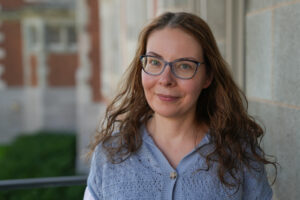
DOI: https://www.doi.org/10.69732/VDRI5711
On a quiet morning in June 2021 I walked into the GULAG History Museum in Moscow, Russia. Of course, I knew about the GULAG (the system of labor camps that functioned across the Soviet Union, or USSR, from the early 1930s to the late 1950s) from high school history classes and various literary works, but, having grown up in a different city, I had not been to the museum before. I stayed there for the entire day, pausing in each hall to watch the interviews with the survivors and study the maps, information stands, and artifacts. Before leaving, I stopped at the Museum shop and noticed a book, a collection of graphic novels, the first of which featured a life story of Boris Zhelezovsky, whose letters to his daughter just a couple hours prior brought me to tears in one of the museum halls. I bought the book, and read it, and cried, and thought that I would want to share it with my students one day, but then I returned to the US, got busy, and almost forgot about the idea.
Seven months later, Russia invaded Ukraine, and everything changed for me as a Russian and as a teacher of the Russian language. Of course, the choice of reading and audio/video materials is always important in a language classroom, because such materials should be authentic, proficiency level-appropriate, engaging, and providing cultural enrichment. However, since the beginning of the war, this choice in a Russian classroom became particularly complicated. Ignoring the war altogether did not seem ethically possible for me, but it was also important to avoid platforming contemporary voices from Russia or exploiting stories of people suffering in Ukraine right now, many of whom probably wouldn’t want their stories to be told in Russian in the first place. That was when I thought about history and about the book I had on my shelf.
It is widely acknowledged in the field of language teaching that culture or cultures associated with the target language are an important part of the curriculum. It is also implicitly assumed that history falls under the broad understanding of culture and thus may have a place in a foreign or second language classroom. However, there has been very little to no systematic research into incorporating history into a foreign language classroom, and into a Russian language classroom in particular. Thus, it is unclear how common the practice of including history in language curricula actually is, but perhaps if it was widespread, there would have been more studies investigating it. It is easy to imagine the reasons why Russian language teachers may not want to include history in their lessons, as mainstream Russian language textbooks do not tend to include it unless it pertains to the biography of a prominent writer or artist and teachers may not feel prepared or trained enough to talk about history themselves. Furthermore, when it comes to any complex historical event (i.e., a war, revolution, or mass repressions), it may be difficult to choose reliable sources and the appropriate framing for such an event. For example, the Soviet, and subsequently Russian, narrative of World War II differs significantly from the one generally adopted by European and American historians. The war itself is largely known under a different name, the Great Patriotic War, and has a narrower timeline: June 22, 1941 — May 9, 1945 vs. the widely accepted September 1, 1939 – September 2, 1945.
Political repressions in the USSR are one of the complex events that are very difficult to discuss in the classroom, and yet discussing them is crucial. Repressions left a profound impact on the societies of all former Soviet republics, on many so-called satellite countries (formally independent but heavily influenced by or even dependent on the USSR politically and economically), and on immigrants from the region whose descendents can be found in countries all over the world, including the United States. Knowing this part of Soviet history is important for understanding many of the 20th century and later literary works, movies, and other forms of art that students may encounter throughout their Russian studies. Just a simple example: The Diamond Arm, a 1969 Soviet comedy that is very often shown in Intermediate-High and Advanced Russian language classes, features the following joke: a newly made acquaintance cheerfully suggests to two main characters to visit them if they ever happen to go to Kolyma, and one of the invited chokes on his drink. The reason for choking cannot be understood without knowing that Kolyma, a region in the Far East, was the place where some of the most feared and difficult to survive labor camps functioned.
There is another reason why discussing the history of mass repressions in a Russian classroom may be particularly relevant: it may allow for a better understanding of the tensions between contemporary Russia and many other former Soviet republics, because political repressions often targeted, among other people and communities, any actual or suspected participants of the national freedom movements in Ukraine, Latvia, Poland, etc. This discussion may provide important historical context for current events that students who study the Russian language are usually following and trying to understand, such as the ongoing war in Ukraine and repressions against anti-war and other political activists in Russia.
Mass repressions in the USSR took many different forms, including the forcible displacement of ethnic minorities, reduced educational and employment opportunities, and the denial of civil liberties. The most dreaded were executions without due process, and the GULAG. From 1936 to 1938 (a period known as the Great Terror, or Great Purge), 700,000 people were executed by firing squads. Overall, about 20 million people went through the GULAG, a system of labor camps that functioned in the USSR from 1929 to 1956. It is estimated that about 5 million were sent to the camps purely for political reasons, and about two million people died in the camps.
The Survivors (“Вы-жившие”), the book I bought at the GULAG History Museum and remembered about after the beginning of the invasion, is a collection of four graphic novels based on real stories featured in the permanent exhibition of the museum https://gmig.ru/en/. The protagonists of these stories are a girl whose father was arrested and died in a labor camp, a young woman from Ukraine who helped soldiers during the Nazi occupation and was sent to a camp for ‘collaborating with the enemy’, a researcher who was arrested as part of a large-scale arrest campaign against the local activists in Siberia, and a woman who grew up in an orphanage because her parents were arrested and killed when she was only two years old.
In the University of Minnesota Russian program where I teach, the fourth-semester Russian class includes a reading module that is intended to help students start reading literary texts in Russian. Each instructor is at liberty to choose the texts for the module, and this choice is critical, because the texts should be engaging, challenging, yet still accessible for learners whose reading proficiency typically ranges from Intermediate-Mid to Advanced-Low. The Survivors fit all of those criteria, and when I was planning my Spring 2023 reading module, I chose it as the main text, supplemented by two short stories by Varlam Shalamov, a labor camp survivor and a prominent poet and writer.
Because this book is a museum project, it comes with photos, documents, and interviews with the people whose stories are told or with their family members. The website also offers The Memory Lesson, a publicly available lesson plan developed by the GULAG museum for use in secondary schools across Russia. The lesson plan (in Russian) is available at https://gmig.ru/upload/iblock/a98/g40ngsvrfaz8w57vi4rvtivaopzfy0kc.pdf. One of the activities proposed in The Memory Lesson involves students looking up their family names in a database and writing down the information about people using stickers of different colors, depending on whether the person was executed or survived. Then students would place those stickers on a timeline (1929 – 1956, the official dates of the GULAG operation) by the date of arrest, look for patterns, and have a teacher-facilitated discussion about their findings. The premise of the activity is that the overwhelming majority of Russian secondary school students would be able to find either their own last name or the last name of a relative or a family friend in the database and thus see a personal connection to the history of their country.
In this article, I will talk about how I adapted this activity for my Russian as a foreign language classroom.
Adapting the Activity
1. Choosing the Database
There are several databases of the victims of mass repressions in the USSR, but the two that are most widely known are the Memorial database (the oldest of all, started in 1998 by Memorial, an international human rights organization founded in 1980 to research and preserve the memory of the victim of Stalin’s repressions and which was closed by a court order in 2021) and the Open List database (a wiki-based website launched in 2016; currently the largest of the two databases). The Memorial database entries include text only, while Open List entries include photographs, narrated biographies, and links to additional materials (e.g., interviews or other publications), if those are available.
Although the original Memory Lesson activity suggested working only with the Memorial database, I decided that the differences in website navigation and types of information included would make using both databases or allowing students to choose one of the two themselves a better approach for the Russian as a foreign language classroom .
2. Choosing the Names
While Russian secondary school students are expected to find their own or familiar last name in the database, could the same expectation be applied to students without any heritage ties to the USSR or its neighboring countries? I found that, generally speaking, it can, although helping students with alternative spellings of their names may be necessary. For example, the Memorial database brings up seven entries for Zhou, three for Smith, five for Johnson, two for Wong, 213 for Wolf(f), and a whopping 2403 for Lee/Li (the spelling would be the same in Russian). I chose these names as examples to show that the repressions were truly a mass event, and people of many racial and ethnic backgrounds who happened to be living in the USSR at the time when the GULAG was operational could become the victims.
However, not all foreign names could be found in the database (e.g., McNamara or James). In this case, it may be a good idea to provide students with a list of relatively common last names to choose from. Importantly, the list should include a variety of names that would represent the ethnic and racial diversity of the victims: Russian, Ukrainian, Polish, Jewish, Tatar, Uzbek, Chechen, Yakut, etc. A sample list for this assignment can be found in this Google doc. Of course, students can also try the names of their favorite literary characters, athletes, or other famous people, including historical figures (e.g., there are 150 entries for Marx, 23 for Lenin, and three for Stalin in the database!).
3. Navigating the Website
For Russian-speaking secondary school students this activity is technically quite simple, because they can easily navigate the Russian website interface. However, in a Russian as a foreign language class, using an unfamiliar website with the entire interface in Russian could present quite a challenge. For example, let’s have a look at the Memorial database entry page (see screenshot below). While the search button can be found intuitively, because it is marked by a different color, there are five search fields to fill out before clicking that button: last name (фамилия), first name (имя), patronymic (отчество), year of birth (год рождения), and place of birth (место рождения). To the further confusion of the user, two of the fields (patronymic and year of birth) are not visually separated on the screen.
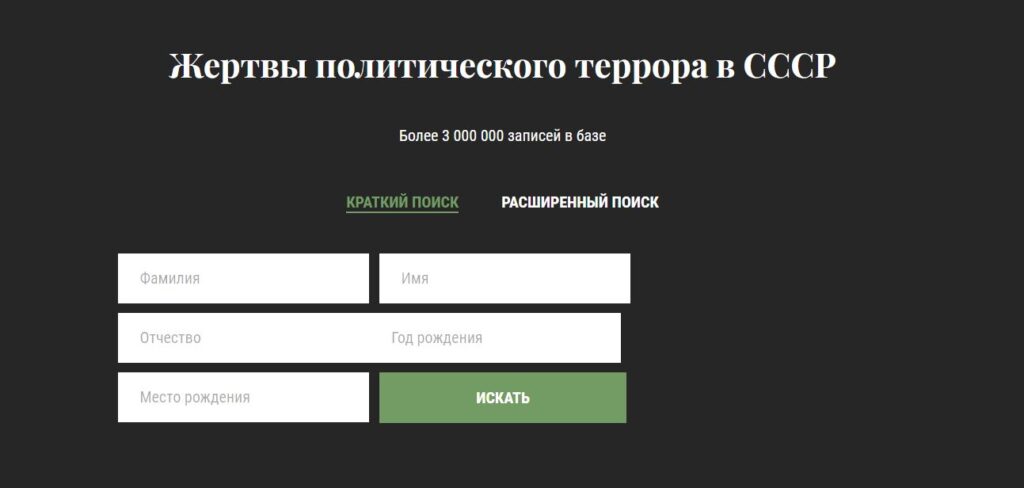
Filling out any one of the fields would be enough to launch the search, but that needs to be explicitly explained to a student. Because entering information not matching the description of the field (e.g., first name into the last name field or the other way around) may result in a failed search with no entries found, simply asking students to “look up the names” in the database may not be a successful strategy.
There are two ways to make this easier for students. One involves providing detailed instructions with screenshots actively helping students while they are performing the search, or combining instructions with active help. Another solution is to encourage students to use another database, Open List, that has simpler navigation with only one search field at the top (see screenshot). Because I was working with the databases for the first time, I wanted to give students a choice and see which database they would prefer. I would probably only use the Open List database the next time I am using this activity, due to the simplicity of the interface and the multimedia component it includes for some of the entries, as well as several other features that I will describe later. However, a sizable minority of my students commented that they, in fact, preferred the text-only Memorial database entries due to their visual simplicity and less “noise“ to pay attention to on the page while they were trying to understand the text.
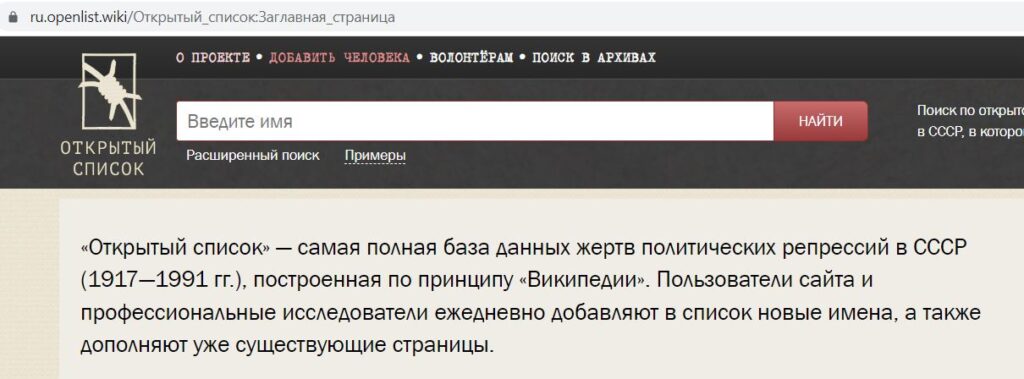
4. Interpreting the Entry
If a viable search term has been used, the students would see one or more database entries. By clicking on one, they would be able to open it and read all information known about a particular victim. In both databases, entries are organized as questionnaire responses (date of birth, date of arrest, sentence, source of information, etc.) which generally scaffolds comprehension.
However, learners of Russian may need additional help and scaffolding. One area where help may be needed is the gender and ethnicity of the people represented in the database. Uzbek, Turkmen, or Dagestani last names do not typically have gendered endings (such as Slavic -ov/-ova, -in/-ina, -oy/-aya, etc.), and if the first name is not one of the unambiguously gendered names students are likely to be familiar with (e.g., Olga or Vladimir), one cannot reliably identify the person’s gender and thus use correct pronouns when talking about that person (e.g., narrating their life story, which could be an activity used in a language class). In this case, the choice of the database may help: while the Memorial database does not include gender in the entries, Open List does, if the information is available. Ethnicity is included in some entries in both databases, although students need to be mindful that the Russian word for it is ‘национальность’, which is a notorious ‘false friend’ that can be easily misinterpreted to mean ‘nationality’ in English.
Another area that requires scaffolding is Russian/Soviet terminology related to legal prosecution and incarceration. Prior to reading the database entries, students need to first learn some relevant specialized vocabulary (e.g., arrest, charges, sentence). This vocabulary can be introduced through a specialized activity, provided in the form of a glossary, or learned inductively, with students trying to reconstruct the usual steps of a prosecutorial process (arrest, pressing charges, trial, sentencing) and map them onto the entry in groups or pairs.
However, vocabulary alone may not be helpful enough. There are also many abbreviations commonly used in the database that the students must learn and understand. For example, the abbreviation ‘вмн’ stands for ‘высшая мера наказания’ (the highest level of punishment) but students need to know that in this period it would be fully synonymous with ‘расстрел’ (an execution by a firing squad). Also, to understand the harshness of a given sentence, it would be important not only to read how many years the person was sentenced to serve but also where exactly they would be serving their sentence. There would be a crucial difference between ‘ИТЛ’ (исправительно-трудовой лагерь – correctional labor camp) and ‘ИТК’ (исправительно-трудовая колония – correctional labor colony), as the latter would function similarly to a prison and mainly house people who had committed minor criminal offenses (e.g., theft or hooliganism), while the former would house political prisoners and criminal offenders with long sentences in a hostile environment (e.g., in the Far North) with an expectation of hard labor, often in dangerous conditions (e.g., in coal mines or at uranium production sites).
Using the Activity in the Classroom
Given all of the considerations above, I planned to dedicate two class periods to the activity. On the first day, I introduced the term ‘GULAG’, showed the interactive map, and played a video interview with Zoya Ivanovna Vyskrebentseva, a labor camp survivor. The interview is a part of the Museum of the GULAG History large video collection available online (the collection on the museum website is available at https://mygulag.ru/ or on the museum’s YouTube channel at https://www.youtube.com/@museumgulag). The choice of this particular interview was based on several considerations. First, the speaker focuses on the story of her arrest and incarceration specifically, and does not deviate much from it, which makes it easier for the listeners to follow. Second, while the overall length of the video is over 20 minutes, the first ten minutes contain the full story from the moment of her arrest to her arrival in the labor camp and can be easily broken down into stages of the prosecutorial process for further discussion. Finally and crucially, this is one of the few interviews from the collection that has both Russian captions and English subtitles (verified, not auto-generated). This allows students to follow the story emotionally, without spending all of their energy on basic comprehension, and then to watch the rest of the interview at home if they would like to.
After watching, I asked questions to prompt students to reconstruct the main events in her journey (e.g., When was she arrested? Where did she spend time before trial? What was the sentence?), and then we looked at her entry in the Open List database (there is no entry for her in the Memorial database) and discussed its structure. I asked students to think what ‘реабилитация’ may mean in this context (it is a cognate of the English word rehabilitation, and refers to the process that began after Joseph Stalin’s death of restoring the political and social rights of the people prosecuted and convicted without due cause) and, after leading them to form the general idea on their own, introduced the concept formally.
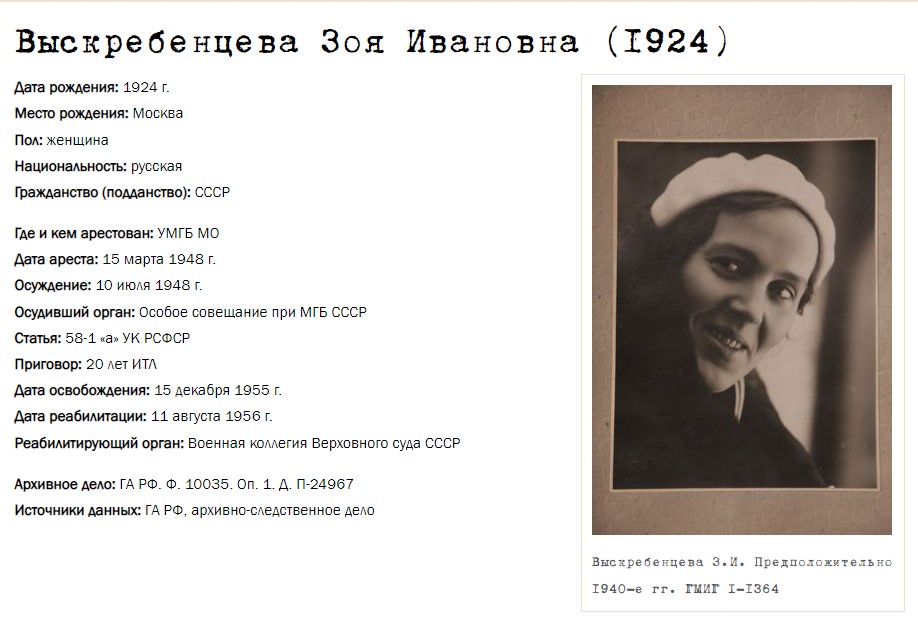
Students’ homework consisted of finding information about three different people in the databases and taking notes. Students could find people with the same last name or three different ones, and they were encouraged to look up each person in both databases. Screenshots with instructions on using the databases were posted on Canvas (our learning management system), along with the reference list of abbreviations, key words, and a list of last names to look up.
On the second day, I began the lesson by asking students to volunteer a few stories they learned through the databases. Some students were surprised to find someone with the same (non-Slavic) last name they had, while others brought up unusual stories. Others discovered entries in which the victim’s date of arrest preceded their date of birth, and we discussed how that could be possible (the explanation is that the person was born in a labor camp, and the date of arrest listed was the date when their mother was arrested).
Then I drew a timeline on a wall-length whiteboard, with 1929 and 1956 serving as the endpoints and 1935, 1940, 1945, and 1950 marked. Students were instructed to write the name of a person and a few key facts about them on a sticky note and place the note on the board to mark the date of their arrest. They also had to choose the color of the sticker depending on the outcome: blue for those who were executed or who died in the camps, yellow for those who were sent to a labor camp but survived and were rehabilitated, pink for those who were sentenced to labor camps but with no further information available, orange for those who received a punishment other than the death penalty or a labor camp (e.g., forced relocation or ban on living near large cities). The results can be seen in the picture below. This timeline could be created using a digital platform for an online course.
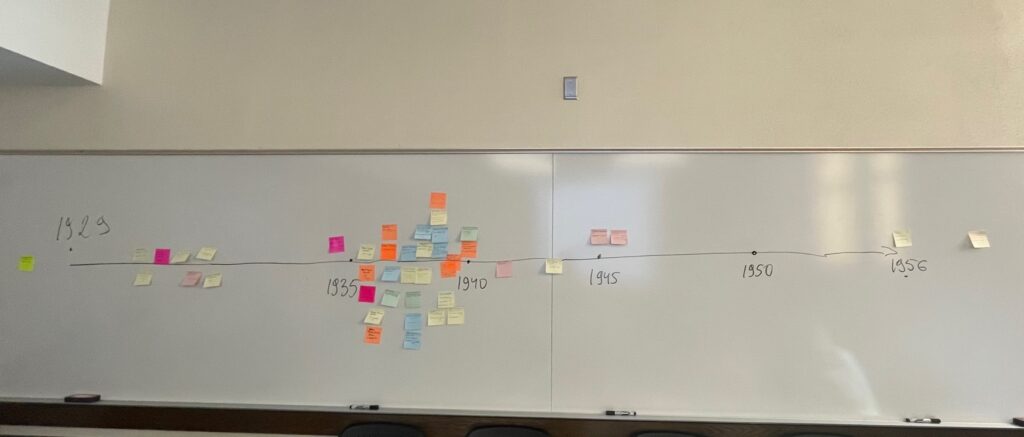
Then came the discussion time. After briefly talking about the stickers that ended up beyond the timeline (which reflects the GULAG as a formally existing system of labor camps, while the databases include all victims of political repressions in the period between 1919 and 1991), we discussed the meaning of the cluster that visibly formed between 1935 and 1940.
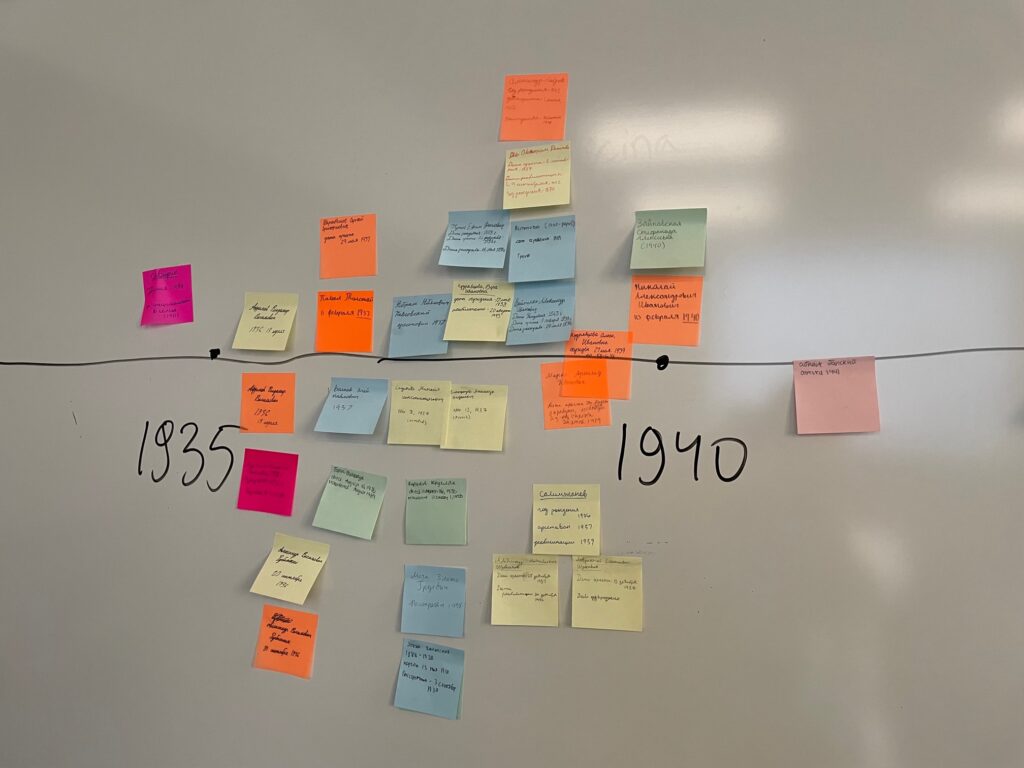
The Impact
The cluster that appeared on the board as a result of looking up random people without any coordination had a very powerful impact on my class, making it easy to understand the term ‘Большой террор’ (the Great Terror) and its rough timeline. Seeing and understanding this timeline (vs. merely reading or hearing about it from me) allowed students to later place the characters of each of the graphic novels and other stories we would read throughout the semester onto this timeline.
We did this activity at the beginning of the third week of the semester, and when we read the first of the graphic novels a few days later, students were quick to notice the significance of the year when the father of the protagonist was arrested (1938). When we were reading The Necktie, a short story by Varlam Shalamov, two weeks before the end of the semester, students wondered why would Marusya, the main character of the story, want to return to the USSR from Japan in 1939, if the Great Terror had just happened.
We kept using the databases throughout the semester to complement the stories told in the graphic novels we were reading. We researched what happened to the characters later (i.e., whether they were rehabilitated, had children or relatives who also went through the GULAG system, etc.), and many students said that it allowed them to better engage with the reading emotionally. Several heritage learners even shared with me that they told their families about the databases and they tried to look up their long lost family members together.
Of course, neither the database activity, nor reading the graphic novels and short stories taught the students comprehensive history of the GULAG, but that was not the goal in the first place. What it did instead was establish a connection between distant history of a foreign country and current events in the region, and between stories of people who lived and suffered many decades ago and students in 2023, learning the language in which those stories exist. Reading graphic novels and stories creates an emotional experience, while using databases helps reinforce this emotional experience with historical data, and when all of that is done through the learners’ target language, the language gains (i.e., new vocabulary) may be expected to be particularly robust.


This is such a creative and important lesson plan – thank you for sharing, Irina!